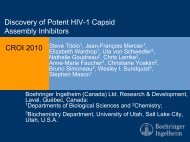Risk and Predictors of HCC in People Less than 40 years of Age ...
Risk and Predictors of HCC in People Less than 40 years of Age ...
Risk and Predictors of HCC in People Less than 40 years of Age ...
- No tags were found...
You also want an ePaper? Increase the reach of your titles
YUMPU automatically turns print PDFs into web optimized ePapers that Google loves.
<strong>Risk</strong> <strong>and</strong> <strong>Predictors</strong> <strong>of</strong> <strong>HCC</strong> <strong>in</strong> <strong>People</strong><br />
<strong>Less</strong> <strong>than</strong> <strong>40</strong> <strong>years</strong> <strong>of</strong> <strong>Age</strong>: Update from<br />
the R.E.V.E.A.L.-HBV Study<br />
Chien-Jen Chen 1,2 , Hwai-I Yang 1,2 , Jun Su 3 , Ch<strong>in</strong>-Lan Jen 1,2 , San-L<strong>in</strong><br />
You 1,2 , Uchenna H Iloeje 3 for The R.E.V.E.A.L.-HBV Study Group<br />
1<br />
Genomics Research Center, Academia S<strong>in</strong>ica, Taipei, Taiwan; 2 Graduate<br />
Institute <strong>of</strong> Epidemiology, College <strong>of</strong> Public Health, National Taiwan University,<br />
Taipei, Taiwan; 3 Research <strong>and</strong> Development, Bristol-Myers Squibb Company,<br />
Wall<strong>in</strong>gford, USA
Background<br />
• Most patients with chronic hepatitis B (CHB)-<br />
related <strong>HCC</strong> develop this complication after the<br />
age <strong>of</strong> <strong>40</strong>. The risk <strong>of</strong> <strong>HCC</strong> <strong>and</strong> its predictors are<br />
well documented for this group <strong>of</strong> people<br />
• There is relatively less knowledge about the risk<br />
<strong>and</strong> predictors <strong>of</strong> <strong>HCC</strong> <strong>in</strong> CHB patients under <strong>40</strong><br />
<strong>years</strong> <strong>of</strong> age<br />
• We analysed the R.E.V.E.A.L. cohort, focus<strong>in</strong>g<br />
on <strong>HCC</strong> risk <strong>in</strong> subjects less <strong>than</strong> <strong>40</strong> <strong>years</strong> old at<br />
enrolment, <strong>and</strong> compared the results to the <strong>HCC</strong><br />
risk <strong>in</strong> subjects over <strong>40</strong> <strong>years</strong> <strong>of</strong> age
Study Population<br />
• Source data: the R.E.V.E.A.L.-HBV study cohort<br />
(N=3,653)<br />
– Population-based prospective study with a mean follow-up <strong>of</strong><br />
11 <strong>years</strong><br />
– Subjects aged 30–65 <strong>years</strong><br />
– At study entry, subjects:<br />
1) provided <strong>in</strong>formed consent;<br />
2) provided a serum sample which was separated on the day<br />
<strong>of</strong> collection <strong>and</strong> frozen at -70ºC;<br />
3) underwent a structured <strong>in</strong>terview by a tra<strong>in</strong>ed public health<br />
nurse;<br />
4) had an ultrasound exam<strong>in</strong>ation<br />
– HBsAg-positive <strong>and</strong> anti-HCV-negative
Methods<br />
• Laboratory tests<br />
– HBsAg <strong>and</strong> HBeAg: radioimmunoassay (Abbott Laboratories,<br />
North Chicago, IL, USA)<br />
– Anti-HCV antibodies: second-generation ELISA kits (Abbott<br />
Laboratories, North Chicago, IL, USA)<br />
– ALT: serum chemistry autoanalyser (Model 736, Hitachi Co.,<br />
Tokyo, Japan) us<strong>in</strong>g commercial reagents (bioMérieux, Mercyl’Etoile,<br />
France)<br />
– Serum HBV DNA level: commercial PCR kits (Cobas Amplicor,<br />
Roche Diagnostics Co., Indianapolis, IN, USA)<br />
• Ascerta<strong>in</strong>ment <strong>of</strong> <strong>HCC</strong> diagnosis<br />
– Data l<strong>in</strong>kage with computerised pr<strong>of</strong>iles <strong>of</strong> the National Cancer<br />
Registry <strong>and</strong> Death Certification<br />
– All <strong>HCC</strong> cases were confirmed as previously described 1<br />
1. Chen CJ, Yang HI, Su J, et al. <strong>Risk</strong> <strong>of</strong> hepatocellular carc<strong>in</strong>oma across a biological gradient <strong>of</strong> serum hepatitis B virus<br />
DNA level. JAMA 2006: 295;65–73.
Results
Basel<strong>in</strong>e demographic <strong>and</strong> disease characteristics<br />
for all REVEAL subjects stratified by <strong>Age</strong><br />
<strong>Age</strong>
Cumulative Incidence <strong>of</strong> <strong>HCC</strong> <strong>in</strong> Subjects < <strong>40</strong><br />
<strong>years</strong> at enrolment<br />
A total <strong>of</strong> sixteen subjects developed <strong>HCC</strong> for an <strong>in</strong>cidence rate <strong>of</strong> 111/100,000 PYFU.<br />
0.0386<br />
0.0281<br />
0.0161<br />
0.0038<br />
0.0034
Basel<strong>in</strong>e demographic <strong>and</strong> disease characteristics for<br />
subjects
Description <strong>of</strong> Subject with basel<strong>in</strong>e HBV DNA<br />
< 300 copies/mL <strong>and</strong> new onset <strong>HCC</strong><br />
• 35 y/o male:<br />
– Serological pr<strong>of</strong>ile at enrollment: HBsAg [+]; HBeAg [-]; anti-HCV [-]<br />
– Biochemical pr<strong>of</strong>ile: At enrolment ALT 86; AST 91 (September 9 th<br />
1991)<br />
– BMI at enrolment: 21.8<br />
– No cirrhosis at enrolment but cirrhosis diagnosed <strong>in</strong> 2002<br />
– No alcohol consumption<br />
– <strong>HCC</strong> diagnosed (November 19, 2001) at age 45 confirmed by<br />
ultrasonography <strong>and</strong> CT<br />
– Subject only had 2 visit dur<strong>in</strong>g study follow-up <strong>and</strong> we can not<br />
describe the serological <strong>and</strong> virological pr<strong>of</strong>ile any further.
Table 3. Incidence rate <strong>of</strong> <strong>HCC</strong> by HBV DNA level<br />
<strong>and</strong> genotype at study entry (per 100,000 PYFU)<br />
<strong>Age</strong>
Table 4. Univariate Cox regression analysis <strong>of</strong><br />
<strong>HCC</strong> for subjects
Table 5. Multivariable Cox regression analysis<br />
<strong>of</strong> <strong>HCC</strong> for subjects
High HBV Viral Load as an Independent <strong>Risk</strong><br />
Factor for <strong>HCC</strong> by <strong>Age</strong> Category<br />
Adjusted hazard ratio* for<br />
<strong>HCC</strong> (95% CI)<br />
18<br />
16<br />
14<br />
12<br />
10<br />
8<br />
6<br />
4<br />
2<br />
0<br />
Participants >=<strong>40</strong> <strong>years</strong><br />
(n=2,437)<br />
‡<br />
p=0.03<br />
#<br />
p
Summary<br />
• The overall <strong>in</strong>cidence rate <strong>of</strong> <strong>HCC</strong> was 111 per 100,000<br />
PYFU for the subset <strong>of</strong> the R.E.V.E.A.L. cohort less <strong>than</strong><br />
<strong>40</strong> <strong>years</strong> <strong>of</strong> age at enrolment<br />
• All <strong>HCC</strong> cases were males; the median time to the <strong>HCC</strong><br />
diagnosis was 9.6 <strong>years</strong> mean<strong>in</strong>g that most <strong>HCC</strong> cases<br />
manifested after <strong>40</strong> <strong>years</strong> <strong>of</strong> age.<br />
• Elevated serum ALT level <strong>and</strong> liver cirrhosis at entry<br />
were statistically significant <strong>in</strong>dependent predictors <strong>of</strong><br />
<strong>HCC</strong><br />
• Increas<strong>in</strong>g age, alcohol consumption, HBeAg status <strong>and</strong><br />
<strong>in</strong>creas<strong>in</strong>g level <strong>of</strong> serum HBV DNA were not significantly<br />
associated with a higher risk <strong>of</strong> <strong>HCC</strong> <strong>in</strong> subjects < <strong>40</strong><br />
<strong>years</strong> old.
Conclusions<br />
• The overall risk <strong>of</strong> develop<strong>in</strong>g <strong>HCC</strong> <strong>in</strong> subjects below<br />
<strong>40</strong> <strong>years</strong> <strong>of</strong> age, over the follow-up period was low<br />
• In this analysis, the presence <strong>of</strong> liver cirrhosis was the<br />
strongest risk predictor <strong>of</strong> <strong>HCC</strong> <strong>in</strong> subjects less <strong>than</strong> <strong>40</strong><br />
• Due to the small number <strong>of</strong> <strong>HCC</strong> cases <strong>in</strong> this young age<br />
group, results from the regression model should be<br />
<strong>in</strong>terpreted with caution<br />
• The predictors <strong>of</strong> <strong>HCC</strong> <strong>in</strong> subjects less <strong>than</strong> <strong>40</strong> <strong>years</strong> are<br />
different from those <strong>in</strong> subjects over <strong>40</strong> <strong>years</strong> <strong>of</strong> age;<br />
more needs to be done to underst<strong>and</strong> this population.<br />
• Serum HBV DNA <strong>and</strong> the presence <strong>of</strong> liver cirrhosis rema<strong>in</strong><br />
the strongest predictors <strong>of</strong> <strong>HCC</strong> risk <strong>in</strong> subjects ≥<strong>40</strong> <strong>years</strong><br />
old





